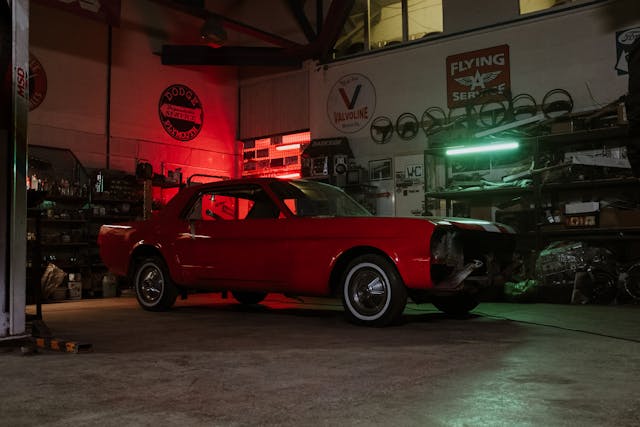Introduction:
The automobile industry’s unwavering quest of innovation and advancement is shown by the history of automotive repair. Car maintenance has changed significantly throughout the years, from the mechanical tinkering days to the digital diagnostics and electric vehicle age. This article explores the development of automobile maintenance from traditional to modern methods, showing how it has changed throughout time.

Initial Maintenance Procedures:
Car maintenance was a hands-on process carried out mostly by owners or competent technicians in the early 20th century. Basic mechanical systems needed frequent maintenance, such as carburetors and ignition timing adjustments, bolt tightening, and lubrication. Because early vehicle engineering was so simple, maintenance duties were often completed by hand and with simple tools.
Growth of Dedicated Service Centers
Specialized service facilities were more and more in demand as automotive technology developed and automobiles got more complicated. Professional maintenance and repair services were offered by independent garages and dealership service departments. To identify and fix problems with engines, gearboxes, brakes, and other mechanical parts, technicians underwent specialized training.
Preventive Maintenance Overview:
In the middle of the 20th century, the idea of preventative maintenance gained popularity, stressing proactive steps to avert malfunctions and increase the lifetime of vehicles. For common maintenance chores like brake checks, fluid flushes, and oil changes, manufacturers started advising regular service intervals. As scheduled maintenance became commonplace, it assisted owners in staying ahead of any issues and averting expensive repairs.
Technological Progress:
There have been substantial technical breakthroughs in car repair over the second part of the 20th century. Vehicle maintenance was completely transformed with the advent of computerized engine control, onboard diagnostics, and electronic fuel injection. Diagnostic tools and software replaced conventional trial-and-error approaches as the preferred means of problem identification and correction for technicians.
Transition to Ecological Sustainability:
Car maintenance procedures have changed to include sustainability in response to rising worries about resource depletion and environmental contamination. In service and repairs, eco-friendly items like recyclable materials and biodegradable cleansers are being used more and more. Additionally, a dedication to lowering carbon emissions and fostering environmental stewardship is shown in the development of energy-efficient technology and alternative fuels, such as electric and hybrid automobiles.
Digital solution integration:
A new age of connectedness and automation in vehicle repair has been brought about by the digital revolution. With the use of real-time diagnostics and warnings for preventive maintenance, car telematics systems allow for remote monitoring of a vehicle’s performance and health. Vehicle owners may streamline their servicing experience by taking advantage of the quick scheduling, booking, and payment options provided by mobile applications and online platforms.
The Rise of Self-Derived Maintenance
The emergence of autonomous cars has the potential to significantly automate the process of automotive maintenance. Artificial intelligence and sophisticated sensors in self-diagnosing cars enable them to identify and resolve problems without human assistance. Predictive analytics and predictive maintenance algorithms improve vehicle uptime and dependability by foreseeing component problems before they happen.
Developments in Manufacturing and Materials:
The field of automotive maintenance has been significantly impacted throughout time by developments in materials science and production processes. Vehicles nowadays are not only more fuel-efficient but also more durable and resistant to corrosion because to the use of lightweight materials like carbon fiber, aluminum, and high-strength composites. To maintain these materials’ lifetime and functionality, certain maintenance methods—such as correct handling and repair procedures—are needed.
Standardization and Globalization:
Standardization of components and maintenance protocols has become more important as the automobile industry has become more globalized. Common standards for systems and parts were implemented by manufacturers, which made it simpler for mechanics to maintain cars of various brands. OBD-II (On-Board Diagnostics), one of the standardized diagnostic protocols, made it much easier to diagnose and fix problems with vehicles of any make or model.

Rules pertaining to the environment and emission control:
Maintenance procedures and emission control technology have advanced significantly as a result of stricter environmental requirements. Technologies used to lower hazardous emissions from automobiles include selective catalytic reduction (SCR) systems, exhaust gas recirculation (EGR) systems, and catalytic converters. To guarantee optimum performance and compliance with emission requirements, these systems must undergo regular maintenance and inspection.
Maintenance for Hybrid and Electric Vehicles:
A paradigm change in auto maintenance has been brought about by the introduction of electric and hybrid automobiles. Electric and hybrid cars have fewer moving components and need less regular maintenance than conventional internal combustion engine automobiles. Normal maintenance chores like oil changes and exhaust system repairs disappear, while new ones like battery management and electric powertrain parts become necessary. In order to properly repair electric and hybrid cars, technicians need to complete specific training.
Predictive analytics and data-driven maintenance:
The use of data-driven maintenance techniques has been made possible by the expansion of vehicle connection and data. Predictive maintenance is made possible by telematics systems, which gather data on vehicle health and performance in real-time based on use trends and component wear. Large-scale data is analyzed by predictive analytics algorithms to spot possible problems before they become breakdowns, allowing for preventive maintenance and reducing downtime.
DIY maintenance and consumer education:
Consumers now have more access to knowledge and resources for DIY (do-it-yourself) maintenance thanks to the internet and online resources. Online tutorials, forums, and instructional videos provide advice on how to solve common problems, carry out routine maintenance, and even do more complex fixes. Giving customers the information and abilities they need to maintain and care for their vehicles not only encourages self-sufficiency but also deepens their grasp of the subject.
In summary:
Numerous variables, such as changes in customer tastes, legal needs, technology improvements, and environmental concerns, have influenced the history of automobile maintenance. The path of automobile maintenance illustrates the continuous search for efficiency, dependability, and sustainability in the automotive industry. It starts with manual maintenance chores carried out by trained technicians and ends with data-driven predictive maintenance plans enabled by connection and automation. The future of auto maintenance looks promising for even more innovation, convenience, and environmental responsibility as we continue to adopt new techniques and technology.

Frequently Asked Questions (FAQ) Regarding the Development of Auto Repair:
1. How has the upkeep of cars changed throughout time?
Advances in technology and connection have facilitated the transition from manual, hands-on car care by experienced technicians to data-driven, predictive maintenance tactics.
2. What significant turning points have occurred in the development of auto repair?
The development of pollution control technology, the introduction of preventative maintenance procedures, the progress made in materials and manufacturing, the appearance of electric and hybrid cars, and the adoption of data-driven maintenance strategies are some of the significant turning points in the industry.
3. How have environmental issues affected the way that cars are maintained?
To reduce the environmental effect of owning and operating a car, environmentally conscious companies have developed emission control technology, adopted eco-friendly materials and products, and implemented sustainable maintenance methods.
4. What part do technical developments play in the upkeep of contemporary cars?
Technological innovations that allow for more effective diagnosis, preventative maintenance, and real-time monitoring of vehicle performance and health include telematics, predictive analytics, and onboard diagnostics systems.
5. How have standards and methods for auto maintenance been impacted by globalization?
Because of increased component and maintenance method uniformity brought about by globalization, servicing automobiles of various manufacturers is now simpler for specialists. Common procedures and standards, such OBD-II, make it easier to diagnose and fix a variety of brands and models.
6. What are some new developments in auto repair?
Rising sales of electric and hybrid cars, the use of autonomous maintenance systems, the incorporation of renewable energy sources for vehicle charging, and an increase in customer awareness and do-it-yourself maintenance are examples of emerging trends.
7. How can customers keep up with the most recent advancements in auto repair?
By following reliable sources like trade journals for the automotive industry, governmental organizations that deal with transportation and the environment, and internet discussion boards and communities devoted to vehicle repair, consumers may keep up to date on current events. Furthermore, going to conferences, seminars, and workshops in the field may provide you important insider knowledge about new trends and best practices.
8. What are the advantages of data-driven, proactive maintenance techniques?
Early identification of possible problems is made possible by proactive, data-driven maintenance practices, which save downtime and expensive repairs. Predictive maintenance algorithms may plan maintenance proactively and anticipate component failures by evaluating vehicle data and use trends. This maximizes vehicle performance and dependability.